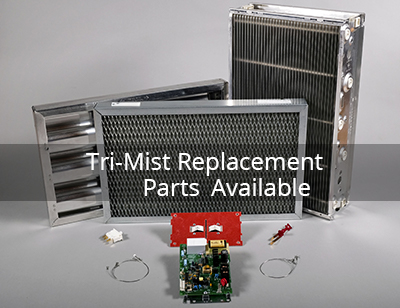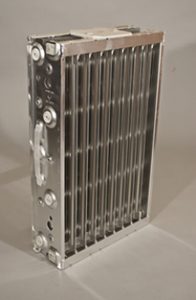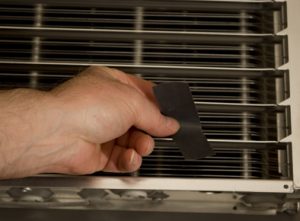Improving Indoor Air Quality
Electrostatic precipitator cells used in industrial air cleaners, when properly maintained and handled with reasonable care, will provide many years of efficient reliable service.
The routine cleaning and maintenance of ESP cells used in industrial air cleaning systems is an important procedure resulting in long life and maximum overall high efficiency for the system. It is wise to set up a preventative maintenance schedule for these systems and adhere to it. Doing so will yield long ESP cell life and high efficiency.
While the information in this article is directed primarily at the Tri-Mist line of ESP Mist Collector cells, these same general cleaning and maintenance procedures apply to most all electrostatic air cleaners.
Tri-Mist Mist Collectors used in machining and grinding operations should be cleaned on a regular periodic basis. A minimum cleaning and maintenance cycle would call for cleaning and inspection four times per year. This of course can vary with the coolants used in the machining operation, the duty cycle of the machine tool and the materials being machined. Depending on the coolant and application, your mist collector may require more or less frequent cleaning. However, a good rule of thumb when starting out is to clean and inspect the collectors once every quarter. Doing so and performing any required maintenance will insure that the units are operating at peak efficiency.
First, open the door and examine the filtration elements. From bottom to top, these consist of two impinger panels followed by two ESP cells followed by a final post filter. Notice the air flow direction arrows on the electrostatic precipitator cells and when reinstalling the cells, be certain that the arrows are facing the correct direction.
There are several ways to clean ESP cells. We will deal with the two most prevalent. The first is to put them in a parts washer and run them through the wash, rinse, dry cycle and the second is to manually clean the cell. We will refer to the latter as the soak method.
Parts Washer Method
The impingers and the ESP cells can be cleaned in an industrial spray washer. It is important to be certain that the cleaning solution used is compatible with the materials of construction used in the manufacture of the impingers and ESP cells. Usually, there is aluminum used in the construction of the ESP cells. Aluminum is a reactive metal so the use of a mild, inhibited alkaline detergent is called for. Any solution that will attack aluminum should be avoided. Likewise, we are often asked if the cells can be cleaned in a solvent. We do not recommend the use of solvents for cleaning ESP cells. When cleaning the cells in an industrial spray washer, be sure to keep the spray pressure at a low volume. We would suggest that it be less than 60 psi. Avoid allowing the pressure of the spray to do any damage to the cell. Industrial spray washers are generally heated. A mild aqueous alkaline cleaning solution heated to 140 degrees F. is sufficient.
Following the wash cycle, the cells should be rinsed well with a clean hot water rinse. If the washer has a hot rinse cycle, that is even better. They can then be carefully blown off with compressed air and inspected.
Manually Cleaning Electronic Cells
Impingers and ESP cells can be manually cleaned in a soak tank. Fill a soak tub with detergent and hot water. As with the parts washer method, it is important to be certain that the detergent is compatible with aluminum. We would suggest a mild alkaline cleaning solution. It is best if you use hot water.
Fully immerse the ESP cell in the hot cleaning solution. Let the cell soak for five or ten minutes. Agitation during the soak process is helpful. The cell can be vertically agitated. Agitation during the cleaning process will help in the removal of contamination due to the hydraulic action of the cleaning solution. As an alternative, you can also construct a manifold and place it in the bottom of the soak tub. Connect the manifold to a compressed air supply and you have a bubbler system to agitate the solution.
After washing, the ESP cell should be thoroughly rinsed with clean hot water being sure that no detergent residue is left on the cell. Carefully blow dry the cell with compressed air.
ESP Cell Inspection
Carefully inspect the mist collector cell. Check all 9 ionizer wires. They should be securely in place, clean and smooth. There should be no dirt or buildup on the wires. If they are rough and not clean and smooth they can be gently touched up with piece of 600 grit emery cloth or an abrasive pad. All scale on the wires should be removed. Replace any ionizer wires that are broken.Carefully inspect the collector plates. They should be secured in place on the connector tubes. Loose collector plates can cause arcing and can only be repaired at the factory. Again take a close look at the collector plates. They should not be touching one another. If any are, gently realign them. Check and be certain that there are no chips or foreign matter wedged between in the collector plates. Blow clean compressed are between the plates. Very small pieces of debris can become wedged between the collector plates and is often difficult to see. Compressed air will usually remove it.
Manually clean the wire mesh impingers. Wash in cleaning solution as outline above and let the dry or blow them off with compressed air. Reassemble the impingers and ESP Air Cleaning Cells back into the mist collector housing. Be careful when reinstalling the cells to observe the air flow direction arrow stamped on the front of the cell.
Summary
Regular cleaning and preventive maintenance is essential to the long life and optimum performance of electrostatic mist and smoke collectors. A regularly scheduled simple maintenance program will go a long way in insuring the long life and high efficiency of your industrial air cleaner’s ESP cells. Best of all, you will have a clean shop. Clear the air. A clean shop leads to greater productivity a healthy environment and healthy employees.




